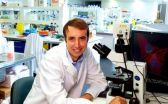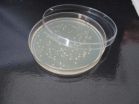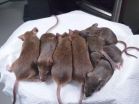(Press-News.org) Flu viruses are a major cause of death and sickness around the world, and antiviral drugs currently do not protect the most seriously ill patients. A study published March 7th by Cell Press in the journal Cell reveals that a compound derived from fats found in fish oils prevents death in influenza-virus-infected mice, even at advanced stages of disease. The study offers a promising strategy for the treatment of patients with severe influenza virus infections.
"Given the potential for future lethal pandemics, effective drugs are needed for the treatment of severe influenza, such as that caused by H5N1 viruses," says senior study author Yumiko Imai of Akita University. "We have identified a novel therapeutic target for the treatment of severe influenza that is effective under conditions where known antiviral drugs fail to protect from death."
Currently available antiviral drugs inhibit influenza virus replication, but they are not typically effective when given to patients as little as 2 days after infection. In an attempt to discover more effective drug targets for influenza, scientists have recently identified several genes and molecules that are crucial for influenza virus replication. However, until now it was not known whether naturally occurring lipids, such as those derived from omega-3 polyunsaturated fatty acids (PUFAs) found in fish oils, might also be involved in influenza virus infections.
To answer this question, Imai and her team screened for PUFA-derived lipids in influenza-virus-infected human lung cells. When they treated infected cells with these lipids, they found that protectin D1 (PD1) was the most effective at inhibiting the replication of viruses, including H5N1.
In addition, low levels of PD1 in the lungs of influenza-virus-infected mice were associated with severe infection and highly pathogenic viruses, such as H5N1. Treatment with PD1 in combination with an approved antiviral drug improved the survival of influenza-virus-infected mice and prevented death, even when given 2 days after infection. "Our findings suggest that PD1could serve as a biomarker as well as a much needed antiviral drug for severe and lethal influenza virus infections," Imai says.
###Cell, Morita et al.: "The lipid mediator protectin D1 inhibits influenza virus replication and improves severe influenza."
Fatty acids could lead to flu drug
2013-03-07
ELSE PRESS RELEASES FROM THIS DATE:
Sniff, sniff. What did you say?
2013-03-07
When animals like dogs or rats sniff one another, there might be more going on than you'd think. Research reported in Current Biology, a Cell Press publication, on March 7th finds in rats that those sniffing behaviors communicate information about an individual's social status. In those encounters, more dominant rats act as primary sniffers, while subordinate sniffees actually slow their breath.
"We know that rats and other animals can communicate through vocalizations, physical contact, odors, and also visual displays," says Daniel Wesson of Case Western Reserve University. ...
When food is scarce, a smaller brain will do
2013-03-07
A new study explains how young brains are protected when nutrition is poor. The findings, published on March 7th in Cell Reports, a Cell Press publication, reveal a coping strategy for producing a fully functional, if smaller, brain. The discovery, which was made in larval flies, shows the brain as an incredibly adaptable organ and may have implications for understanding the developing human brain as well, the researchers say.
The key is a carefully timed developmental system that ultimately ensures neural diversity at the expense of neural numbers.
"In essence, this ...
Using human brain cells to make mice smarter
2013-03-07
VIDEO:
What happens when human brain cells that surround and support neurons are implanted into the brains of newborn mice? Researchers reporting in the March 7th issue of the Cell Press...
Click here for more information.
What happens when human brain cells that surround and support neurons are implanted into the brains of newborn mice? Researchers reporting in the March 7th issue of the Cell Press journal Cell Stem Cell recently found that such mice had enhanced learning and ...
Persistence pays off in solving hemophilia mystery, showing curiosity drives discovery
2013-03-07
An Australian researcher has found the third and final missing piece in the genetic puzzle of an unusual form of hemophilia, more than 20 year after he discovered the first two pieces.
Professor Merlin Crossley, of the University of New South Wales, and his international team studied the blood-clotting disorder, hemophilia B Leyden, which is unusual because symptoms improve after puberty.
The results, published in The American Journal of Human Genetics, explain how more than half of the cases of this rare, hereditary bleeding disorder occur, and could help improve understanding ...
American Academy of Microbiology releases resistance report
2013-03-07
What do cancer cells, weeds, and pathogens have in common? They all evolve resistance to the treatments that are supposed to eliminate them. However, researchers developing the next generation of antibiotics, herbicides, and anti-cancer therapeutics rarely come together to explore the common evolutionary principles at work across their different biological systems. The new American Academy of Microbiology report "Moving Targets: Fighting Resistance in Infections, Pests, and Cancer" concludes that scientists working on different kinds of treatments have much to learn from ...
Dual systems key to keeping chromosomes intact
2013-03-07
USC scientists have discovered how two different structural apparatuses collaborate to protect repetitive DNA when it is at its most vulnerable – while it is being unzipped for replication.
The centromere—the center of the "X" shape of a chromosome—contains repeated DNA sequences that are epigenetically coded to attract so-called heterochromatin proteins. This protects the structure to ensure that the chromosomes separate properly. If the heterochromatin is lost (due to mutations in the cell), the repetitive DNA becomes vulnerable to rearrangements and recombination. ...
New hypothesis: Why bacteria are becoming increasingly more resistant to antibiotics
2013-03-07
According to his theory, bacteria that are non-resistant to antibiotics acquire said resistance accidentally because they take up the DNA of others that are resistant, due to the stress to which they are subjected.
A University of Granada researcher has formulated a new hypothesis concerning an enigma that the scientific community has still not been able to solve and which could revolutionise the pharmaceutical industry: Why are bacteria becoming increasingly more resistant to antibiotics? His work has revealed that the use of antibiotics can even cause non-resistant bacteria ...
New gender benchmarking study: India is making slow progress in advancing women in S & T
2013-03-07
Delhi, March 7, 2013 - In the first gender benchmarking study of its kind, researchers have found that numbers of women in the science, technology and innovation fields are alarmingly low in the world's leading economies, and are actually on the decline in many, including the United States. India's low overall ranking in the study shows slow progress despite women friendly policies which have been in place for a number of years.
The full gender benchmarking study maps the opportunities and obstacles faced by women in science in Brazil, South Africa, India, the Republic ...
New gender benchmarking study: South Africa ranks low on women participating in STI
2013-03-07
Cape Town, March 7, 2013 – In the first gender benchmarking study of its kind, researchers have found that numbers of women in the science, technology and innovation fields (STI) are alarmingly low in the world's leading economies, and are actually on the decline in many, including the United States. For South Africa, results show that women have more opportunities available to them than ever before, however, their participation in the science, technology and innovation workforce remains low.
The full gender benchmarking study maps the opportunities and obstacles faced ...
Japanese researchers succeed in making generations of mouse clones
2013-03-07
Using the technique that created Dolly the sheep, researchers from the RIKEN Center for Developmental Biology in Kobe, Japan have identified a way to produce healthy mouse clones that live a normal lifespan and can be sequentially cloned indefinitely.
Their study is published today in the journal Cell Stem Cell.
In an experiment that started in 2005, the team led by Dr. Teruhiko Wakayama has used a technique called somatic cell nuclear transfer (SNCT) to produce 581 clones of one original 'donor' mouse, through 25 consecutive rounds of cloning.
SNCT is a widely ...



